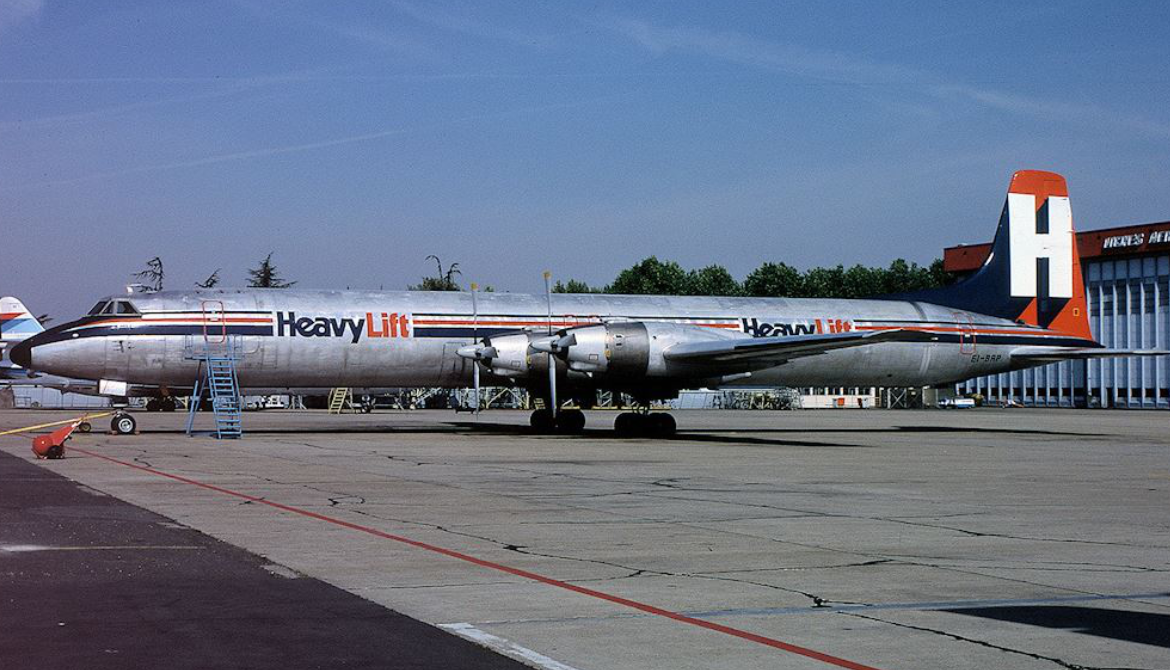Canadair
Canadair CL-44 Yukon
| Role | Military transport aircraft Cargo aircraft |
|---|---|
| Manufacturer | Canadair |
| First flight | 16 November 1959 |
| Introduction | 19 July 1960 (RCAF) |
| Retired | 1971 (RCAF) |
| Primary users | Royal Canadian Air ForceVarious airlines |
| Number built | 39 |
| Developed from | Bristol Britannia |
| Variants | Conroy Skymonster |
.
History Canadair / Bombardier
Canadair CL-44 Yukon

The Canadair CL-44 was a Canadian turboprop airliner and cargo aircraft based on the Bristol Britannia that was developed and produced by Canadair in the late 1950s and early 1960s. Although innovative, only a small number of the aircraft were produced for the Royal Canadian Air Force (RCAF) (as the CC-106 Yukon), and for commercial operators worldwide.
The aircraft is named after the Canadian territory of Yukon.
Design and development
In the 1950s, Canadair acquired a licence to build the Bristol Britannia airliner. Their first use of it was to build the heavily modified Canadair CL-28 Argus patrol aircraft (RCAF designation CP-107) that combined the Britannia's wings and tail sections with a new fuselage and engines. The resulting aircraft had lower speed and service ceiling, but it had two bomb bays and greatly extended loiter times.
Operational history



Initially, the CL-44-6 was produced for the RCAF as the CC-106 Yukon. Once initial problems were resolved, in RCAF service the Yukon performed well and in December 1961, a Yukon set a world record for its class when it flew 6,750 mi (10,860 km) from Tokyo to RCAF Station Trenton, Ontario, in 17 hours, three minutes at an average speed of 400 mph (640 km/h). Later, a Yukon set a new record staying airborne for 23 hours and 51 minutes. These records were unbroken until bettered by the Boeing 747SP in 1975. By the time of their retirement, Yukons had flown 65 million miles, 1.5 billion passenger miles and 360 million ton-miles.
0
KmCeiling
0
KmCombat RANGE
0
Km/hAircraft Speed
0
Max Crew
Photo Gallery
Canadair / Bombardier
Canadair CL-44 Yukon


Canadair / Bombardier
Canadair CL-44 Yukon
General Info
-
-
- Crew: 2 pilots, 1 flight engineer plus loadmasters as required.
- Capacity: 160 passengers and 66,048 lb (29,959 kg) useful load
- Length: 136 ft 11 in (41.73 m)
- Wingspan: 142 ft 4 in (43.37 m)
- Height: 36 ft 8 in (11.18 m)
- Wing area: 2,075 sq ft (192.7 m2)
-
Powerplant
-
- Empty weight: (40,348 kg)
- Max takeoff weight: (95,000 kg)
- Powerplant: 4 × Rolls-Royce Tyne 515/50 turboprops, 5,730 shp each
- Propellers: 4-bladed variable pitch propellers
-
Performance
- Maximum speed: 420 mph (670 km/h
- Cruise speed: 401 mph (646 km/h
- Range: 5,588 mi (8,993 km, 4,856 nmi)
- Service ceiling: 30,000 ft (9,100 m)
.
Links to Youtube & Others
The rollout of the Yukon was a near-disaster because the prototype could not be pushed out of the hangar since the vertical fin could not clear the hangar doors
Canadair
Canadair
CL-44 Yukon
The RCAF specified the CL-44 to be equipped with Bristol Orion engines
Youtube Link
The CC-106 Yukons retired in March 1971 and were replaced by the CC-137 (Boeing 707)












